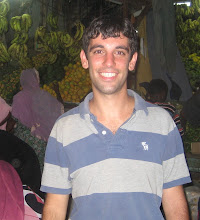Thursday, June 8: Sunrise, Sunset
***Hello!! Here are my first week's journals. I'd love to post pictures, but this "high-speed" internet cafe in Cambodia is really struggling just to get through the text...maybe next time! For those of you new to blogging (mom and dad), scroll on down to the bottom and work your way up to read the week in chronlogical order.
Safe travels to all of you leaving this week and congrats to those finally finishing school!
David
****
Last night I returned from watching the sunset over the rice paddies of Cambodia from my perch at the very top of one of the fascinating Angkor Wat temples. We scrambled up a tall hill and then worked our way up the steep stone steps to the temple’s peak where we gathered with tourists and backpackers from all over the world. As the giant red ball descended, its reflection shone up at us from the shimmering wetlands below, creating the image of a sun rising and setting simultaneously. Funny, because here we are twelve hours ahead of Wisconsin time, so the sun really was rising at home. So hello to all of you at home! The temples of Angkor were truly spectacular. There are hundreds of temple ruins still standing from the reign of the Khmer Empire. This empire, centered around Siem Reap, was the epicenter of culture and development throughout Southeast Asia from the 9th to the 13th centuries. It’s nearly impossible to describe the scope of the ruins—there are literally thousands of acres of intricately carved statues, detailed busts, graphic histories, huge alters, and towering spires. The rocks were carried from the mountains of northern Cambodia by hand on long poles, and over 80,000 people worked on each temple. However, unlike many of history’s great monuments, few slaves labored on the project. It was mostly the king’s subjects, who were paid and happy to work. The temples were not exclusively for royalty; there were schools, hospitals, and worship temples for monks and commoners. The society seemed quite progressive; most people were Buddhist, and then Hindi, and then Buddhist again, but many of the temples were designed to be inclusive of all religions. Thus, few of the structures had any real recognizable religious figure, but there were scenes upon scenes of mythical creation stories, gods hunting, and people living with celestial deities. The most famous and best restored temple is Angkor Wat, where the king worshipped and was eventually buried. The walls surrounding the complex feature hundreds of yards of stories detailing the mythical and actual history of the empire. The complex works its way inward to a giant pyramid, soaring over the surrounding fields. From the top, the look down at the gargantuan temples was breathtaking! The restoration work on the temples is slow and painstaking, with many countries working on one or two temples. Yet, there are almost no restrictions for visitors, so we could climb steep pyramid sides, crawl through low hallways, peer into dark shrines at unprotected carvings and statues, and take our pictures anywhere. For those of you who have seen it, Tomb Raider was filmed here, in the thick jungle and tall trees slowly creeping in on the temples to take them over. You could easily spend weeks or months here, but we did our best to get as much into a 12 hour day of touring as we could. Last night we finally had a chance to kick back a few in the local nightclubs, enjoying Angkor Beer, the national beer of Cambodia served ubiquitously. We’re taking it a bit easy this morning, as we all catch up on journals and sleep, and at noon we will begin to brave the roads again, setting off to Cambodia’s capital, Phnom Penh.


0 Comments:
Post a Comment
<< Home